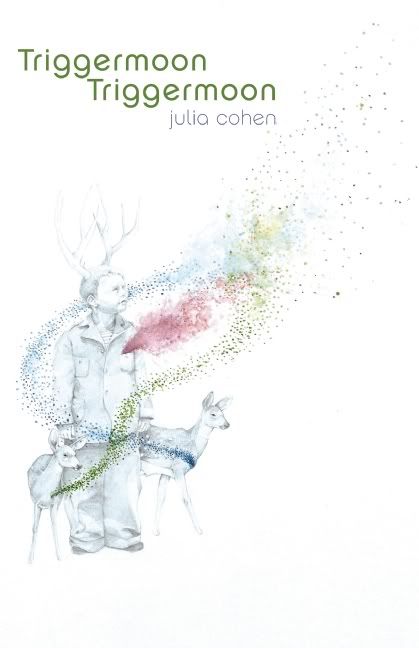
"What have I done to this world" (9), asks the speaker of "There Was a Bridge of Tattered Rugs," which is the opening poem of Julia Cohen's Triggermoon Triggermoon (Black Lawrence Press, 2011). She poses the question, it would appear, in response to the series of images that precede it: "A nightgown soaked in milk / The bassinet in the greenhouse / A boat-shaped spider crabbing the high corner." The world she creates, the one she questions, is a world populated by images slightly askew, each separated by (oftentimes) large associative leaps.
These poems, then, alter our world to the extent that it becomes a "non-world" that "occasionally rolls over" us, producing "Birdsongs [that] appear as abstract patterns" (14). But if we are to piece together something more than abstract patterns, we are told that our eyes must "darken to enliven the birdsong" (14) and form more concrete, visible images. I can only assume that to darken our eyes, we must close them [1] and let the imagination (i.e. our mental imagery) take over.
Perhaps the poem that expresses this strange state the best, at least with regard to the rhetoric of its content, is the first section of "Hello, Goodly," which follows in its entirety:
Perhaps the poem that expresses this strange state the best, at least with regard to the rhetoric of its content, is the first section of "Hello, Goodly," which follows in its entirety:
When you practiced reading on the couchin Rhode Island, it was the goodly soundof the weekend'I have trouble with my sentencing.'It is true that I had woken up & may havebeen disoriented.It is also true that during momentsof sleepy confusion as we rise, time, with usin it, has the most clarity.It is when I am the most confident & the mostvulnerable—to sit by you & secretly wateryour shoulder in the right way.'Do you see the pear treegrowing between the couch cushions? (52)
Waking up in a "sleepy confusion," wherein the mind is still "disoriented," the speaker is both confident and vulnerable. The competing tensions in these moments (manifested in troubling sentences) create an amalgamation of fantastical imagery, such as a "pear tree / growing between couch cushions." A pear tree and a couch cushion, unto themselves, provide little in the way of the extraordinary; but when combined, they produce a "non-world" in which the "something living in these / lives I've not yet found" (47) is found.
[1] It's important to remember, though, that "When we shut out eyes they are actually still open only / covered by a lid" (60); in other words, just because our eyes are "closed," we do not detached from reality, merely interpret reality from a different, darker perspective.

No comments:
Post a Comment